
Vincent Willem van Gogh was a Dutch post-impressionist painter who posthumously became one of the most famous and influential figures in the history of Western art. In a decade, he created about 2,100 artworks, including around 860 oil paintings, most of which date from the last two years of his life. They include landscapes, still lifes, portraits and self-portraits, and are characterised by bold colours and dramatic, impulsive and expressive brushwork that contributed to the foundations of modern art. He was not commercially successful, and his suicide at 37 came after years of mental illness, depression and poverty.
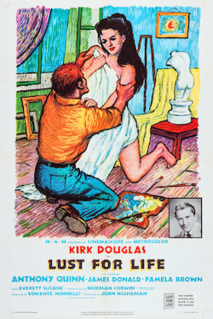
Lust for Life is a 1956 American biographical film about the life of the Dutch painter Vincent van Gogh, based on the 1934 novel of the same title by Irving Stone which was adapted for the screen by Norman Corwin.
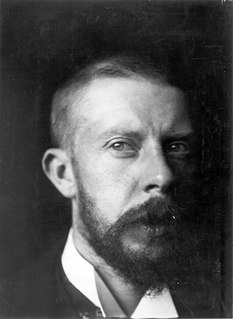
George Hendrik Breitner was a Dutch painter and photographer. An important figure in Amsterdam Impressionism, he is noted especially for his paintings of street scenes and harbours in a realistic style. He painted en plein air, and became interested in photography as a means of documenting street life and atmospheric effects – rainy weather in particular – as reference materials for his paintings.
Irving Stone was an American writer, chiefly known for his biographical novels of noted artists, politicians and intellectuals. Among the best known are Lust for Life (1934), about the life of Vincent van Gogh, and The Agony and the Ecstasy (1961), about Michelangelo.

The Potato Eaters is an oil painting by Dutch artist Vincent van Gogh painted in April 1885 in Nuenen, Netherlands. It is in the Van Gogh Museum in Amsterdam. The original oil sketch of the painting is at the Kröller-Müller Museum in Otterlo, and he also made lithographs of the image, which are held in collections including the Museum of Modern Art in New York City. The painting is considered to be one of Van Gogh's masterpieces.
Lust for Life may refer to:

Theodorus van Gogh was a Dutch art dealer. He was the younger brother of Vincent van Gogh, and Theo's unfailing financial and emotional support allowed his brother to devote himself entirely to painting. Theo died at the age of 33, six months after his brother died at the age of 37.

The fame of Vincent van Gogh began to spread in France and Belgium during the last year of his life, and in the years after his death in the Netherlands and Germany. His friendship with his younger brother Theo was documented in numerous letters they exchanged from August 1872 onwards. The letters were published in three volumes in 1914 by Johanna van Gogh-Bonger, Theo's widow, who also generously supported most of the early Van Gogh exhibitions with loans from the artist's estate. Publication of the letters helped spread the compelling mystique of Vincent van Gogh, the intense and dedicated painter who suffered for his art and died young, throughout Europe and the rest of the world.

This is a list that shows references made to the life and work of Dutch artist Vincent van Gogh (1853–1890) in culture.

Johanna Gezina van Gogh-Bonger was a Dutch editor and translator of the letters of the van Gogh brothers. She was the wife of Theo van Gogh, art dealer, and the sister-in-law of the painter Vincent van Gogh and became a key player in the growth of Vincent's fame.

Vincent & Theo is a 1990 biographical drama film about the Dutch painter Vincent van Gogh (1853–1890) and his brother Theo (1857–1891), an art dealer. While Vincent Van Gogh's artworks are now famous, he was essentially unrecognised in his lifetime, and survived on his brother's charity. The film was directed by Robert Altman, and starred Tim Roth and Paul Rhys in the title roles.
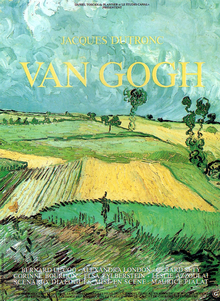
Van Gogh is a 1991 French biographical drama film written and directed by Maurice Pialat. It stars Jacques Dutronc in the role of Dutch painter Vincent van Gogh, for which he won the 1992 César Award for Best Actor. Set in 1890, the film follows the last 67 days of Van Gogh's life and explores his relationships with his brother Theo, his physician Paul Gachet, and the women in his life, including Gachet's daughter, Marguerite.

Japonaiserie was the term the Dutch post-impressionist painter Vincent van Gogh used to express the influence of Japanese art.
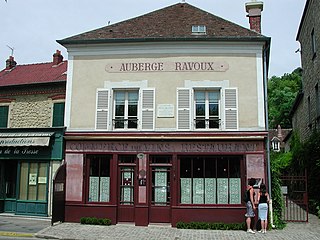
The Auberge Ravoux is a French historic landmark located in the heart of the village of Auvers-sur-Oise. It is known as the House of Van Gogh because the Dutch painter Vincent van Gogh spent the last 70 days of his life as a lodger at the auberge. During his stay at Auvers, Van Gogh created more than 80 paintings and 64 sketches before shooting himself in the chest on 27 July 1890 and dying two days later on 29 July 1890. The auberge (inn) has been restored as a museum and tourist attraction. The room where Van Gogh lived and died has been restored and can be viewed by the public.

Van Gogh's family in his art refers to works that Vincent van Gogh made for or about Van Gogh family members. In 1881, Vincent drew a portrait of his grandfather, also named Vincent van Gogh, and his sister Wil. While living in Nuenen, Vincent memorialized his father in Still Life with Bible following his death in 1885. There he also made many paintings and drawings in 1884 and 1885 of his parent's vicarage, its garden and the church. At the height of his career in Arles he made Portrait of the Artist's Mother, Memory of the Garden at Etten of his mother and sister and Novel Reader, which is thought to be of his sister, Wil.

Vincent van Gogh drew and painted a series of works of his mistress Sien during their time together in the Netherlands. In particular, his drawing Sorrow is widely acknowledged as a masterwork of draftsmanship, the culmination of a long and sometimes uncertain apprenticeship in learning his craft.

Trees and Undergrowth is the subject of paintings that Vincent van Gogh made in Paris, Saint-Rémy and Auvers, from 1887 through 1890. Van Gogh made several paintings of undergrowth, a genre called "sous-bois" brought into prominence by artists of the Barbizon School and Impressionists. The works from this series successfully use shades of color and light in the forest or garden interior paintings. Van Gogh selected one of his Saint-Rémy paintings, Ivy (F609) for the Brussels Les XX exhibition in 1890.
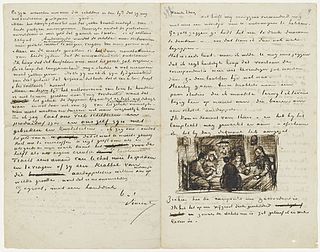
The Letters of Vincent van Gogh refers to a collection of 903 surviving letters written (820) or received (83) by Vincent van Gogh. More than 650 of these were from Vincent to his brother Theo. The collection also includes letters van Gogh wrote to his sister Wil and other relatives, as well as between artists such as Paul Gauguin, Anthon van Rappard and Émile Bernard.
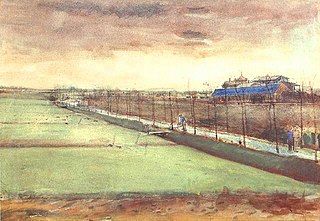
Meadows near Rijswijk and the Schenkweg is a watercolor by the Dutch painter Vincent van Gogh that he made in January 1882, shortly after taking up residence in The Hague.

Vincent van Gogh is an 1886 oil on canvas portrait painting by Australian artist John Russell. It depicts Dutch artist Vincent van Gogh, who became lifelong friends with Russell after meeting him at Fernand Cormon's atelier in Paris, which they both attended. Painted in a realist and academic manner, the portrait shows hints of the impressionist techniques that Russell and Van Gogh began experimenting with in the latter half of the 1880s.


















